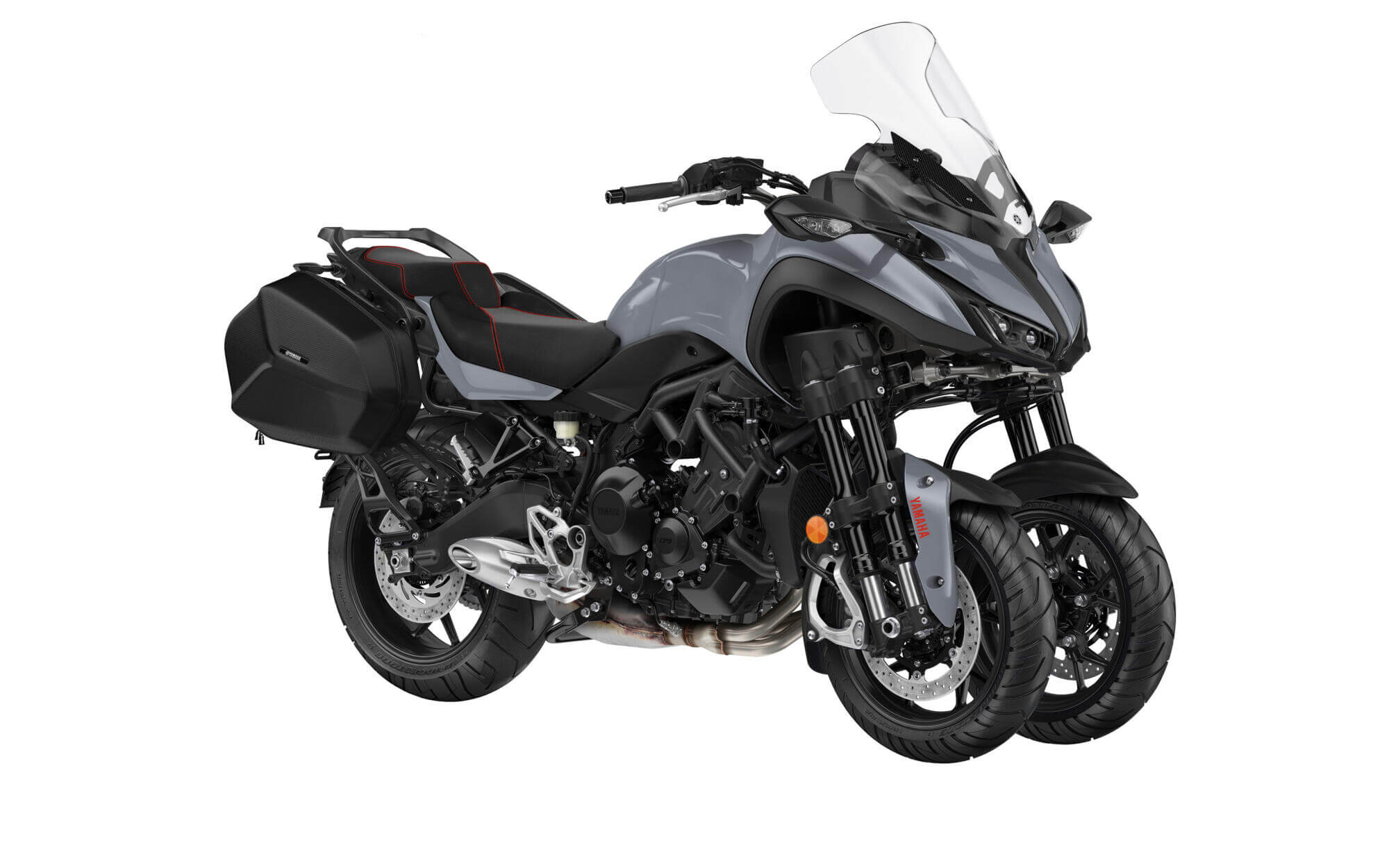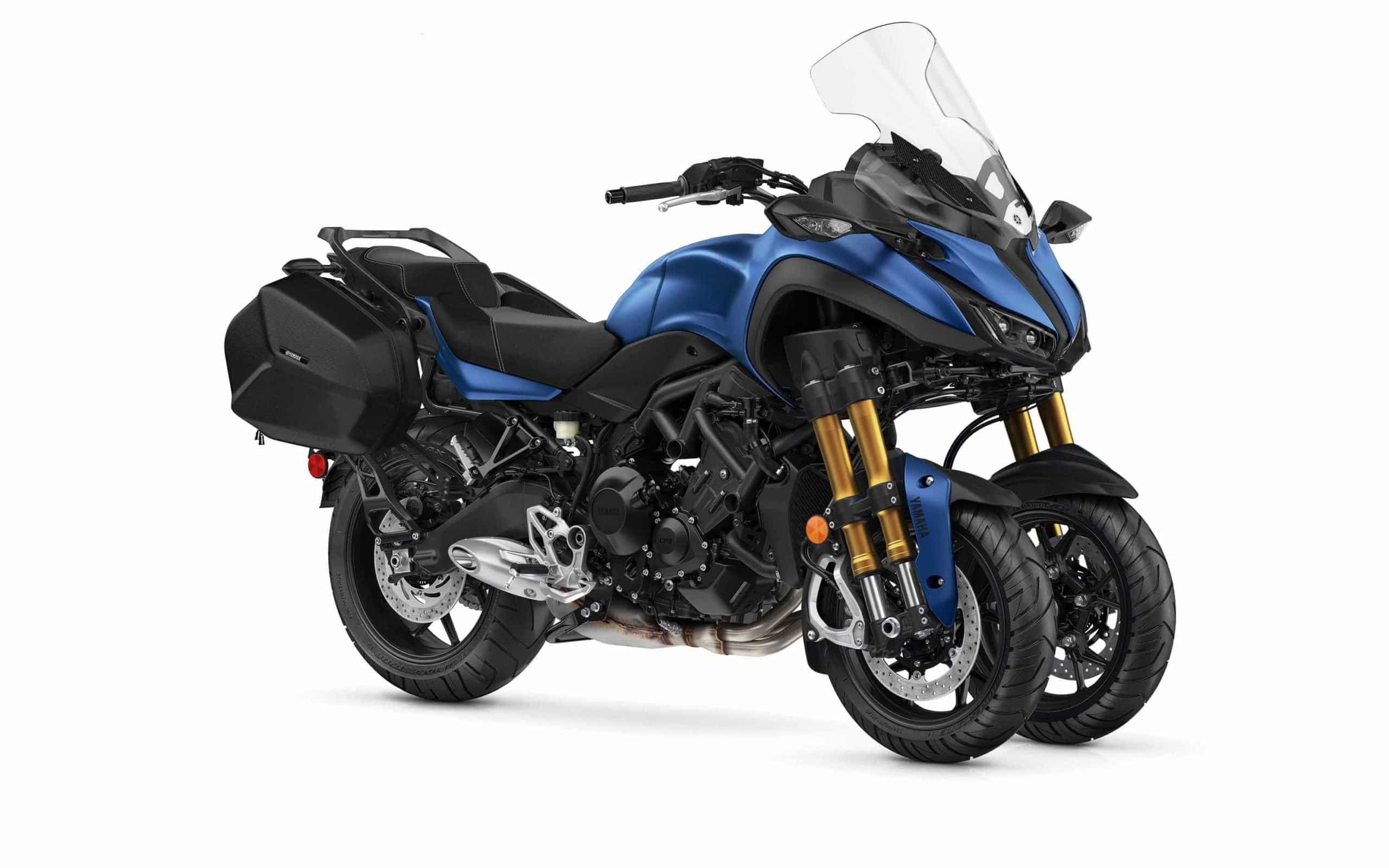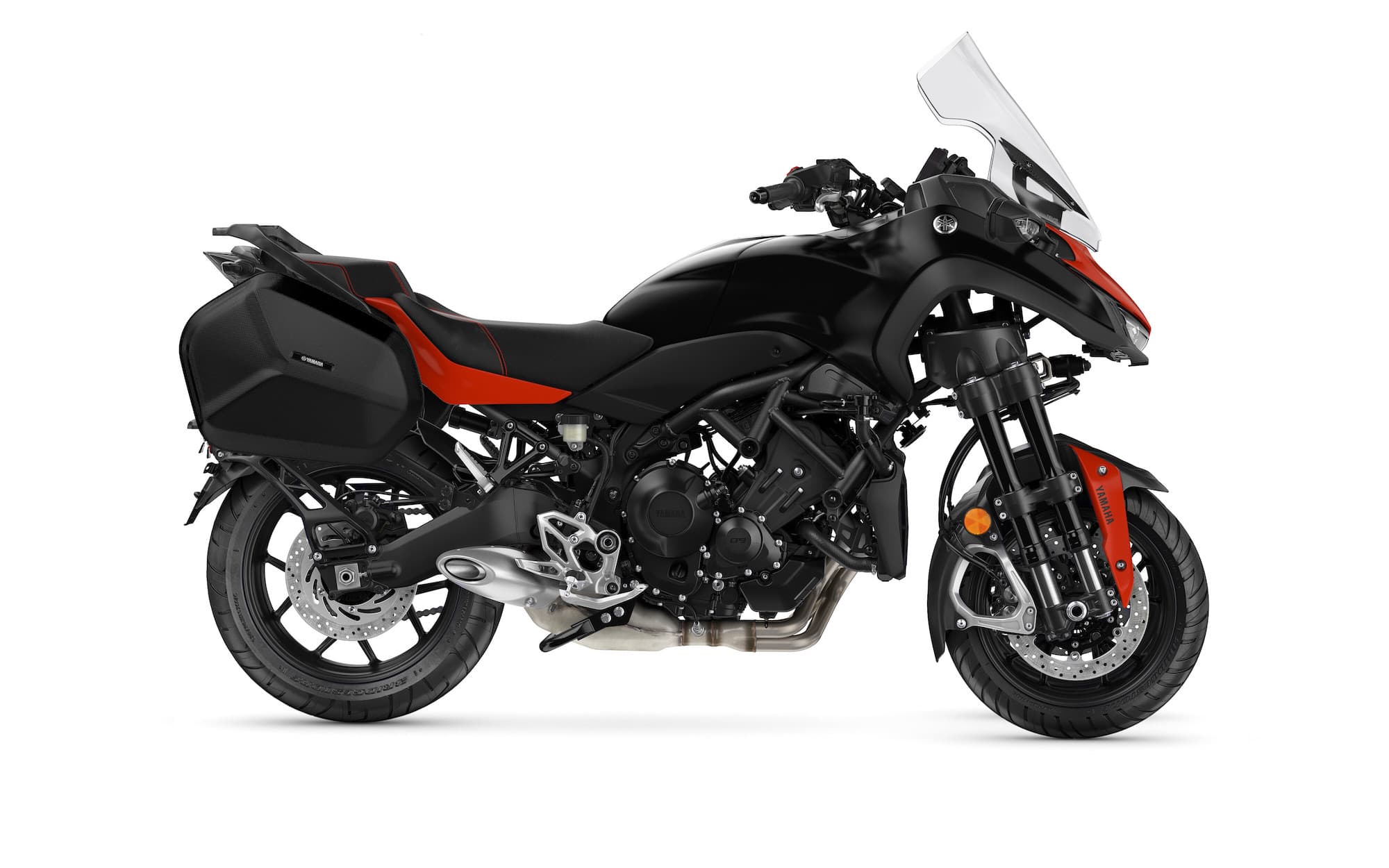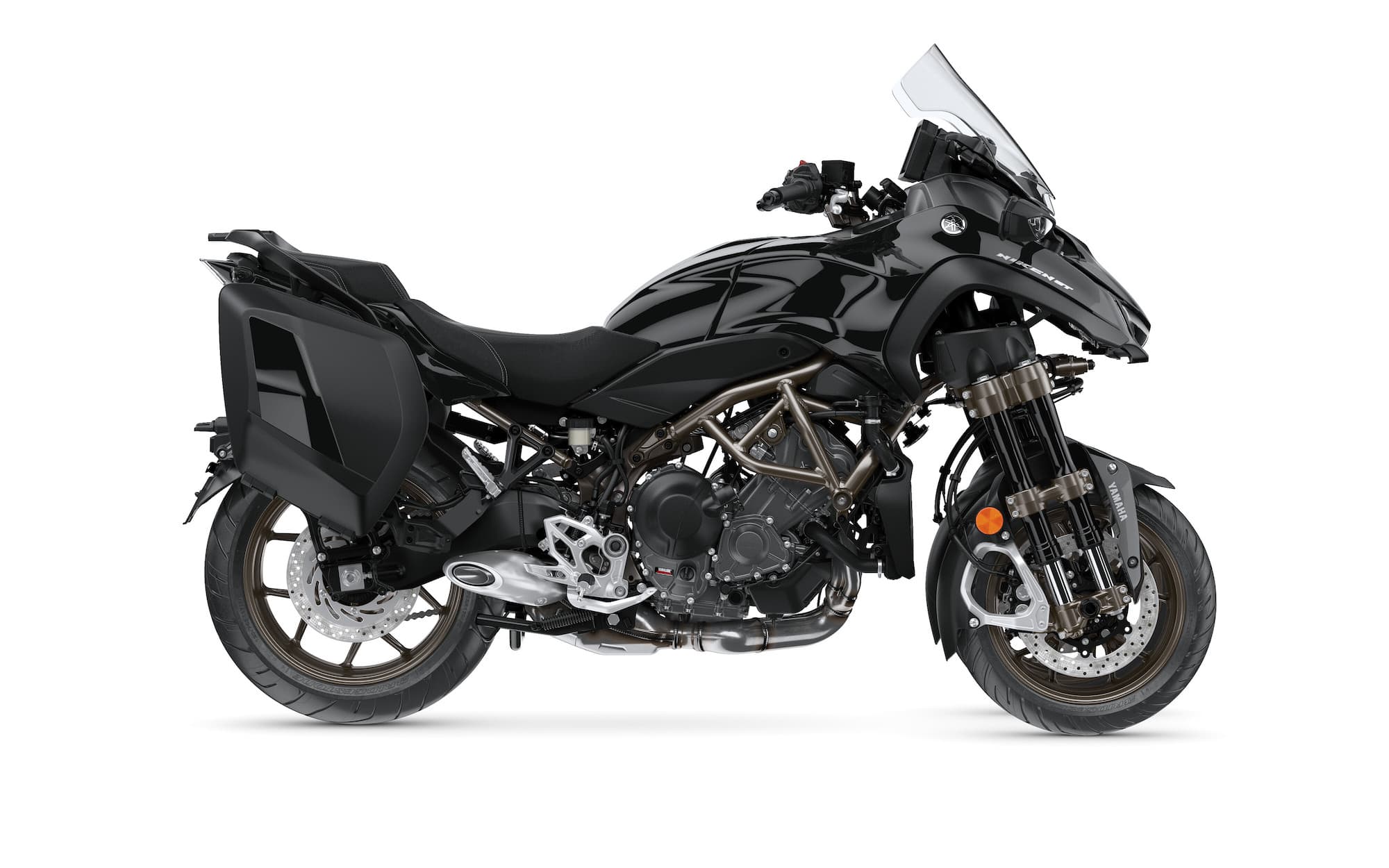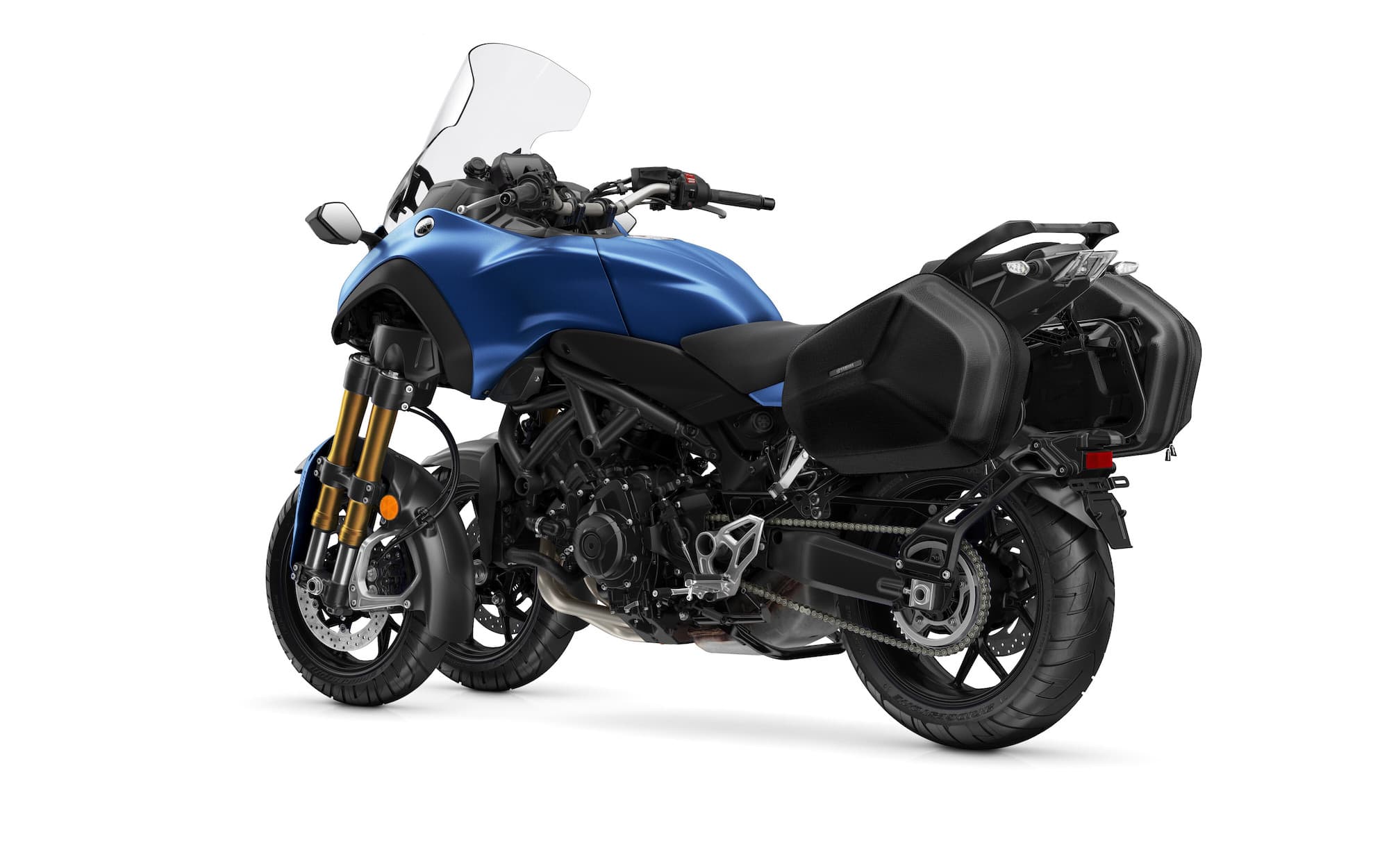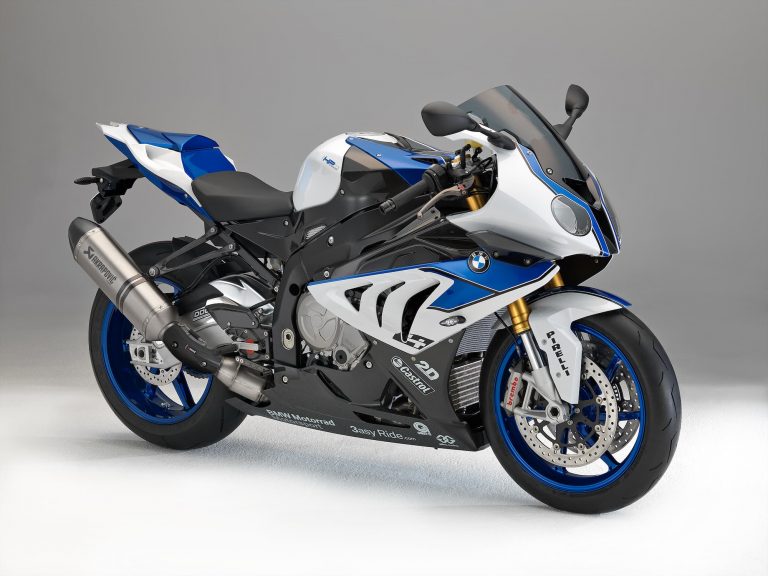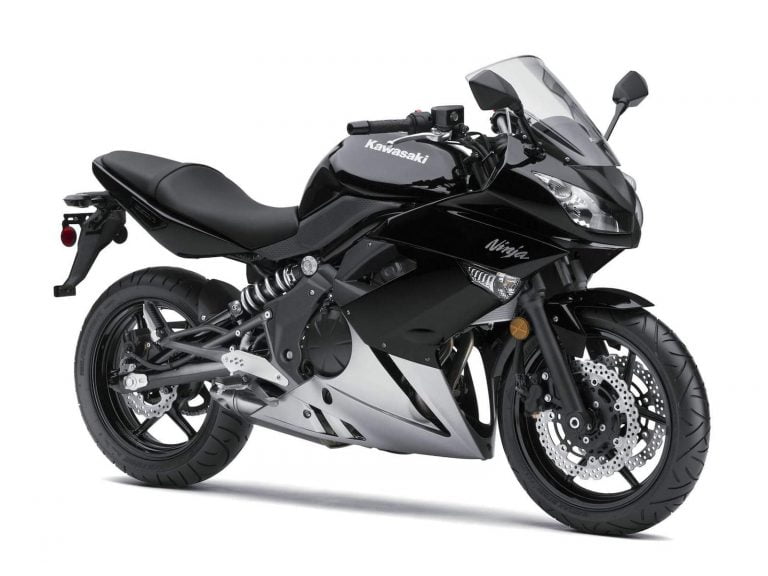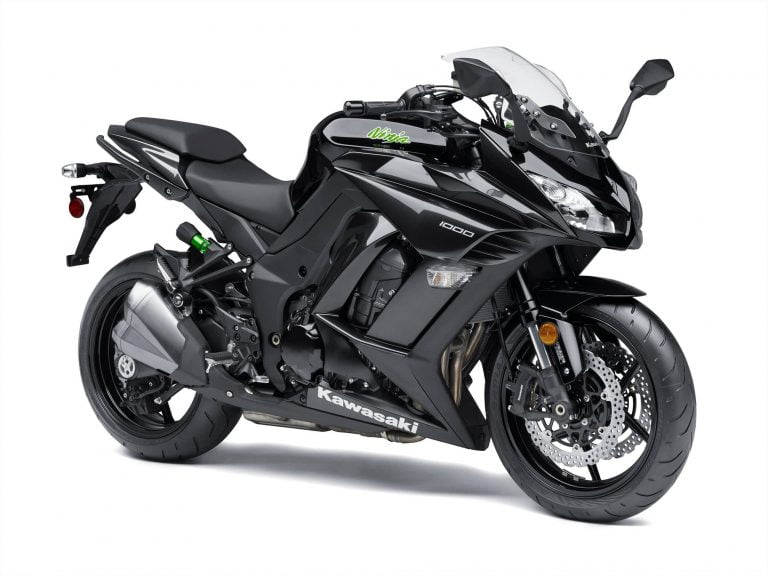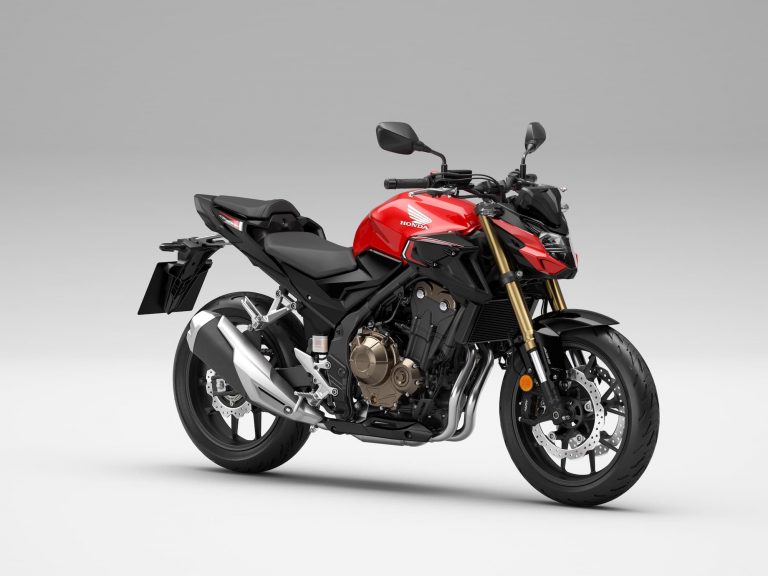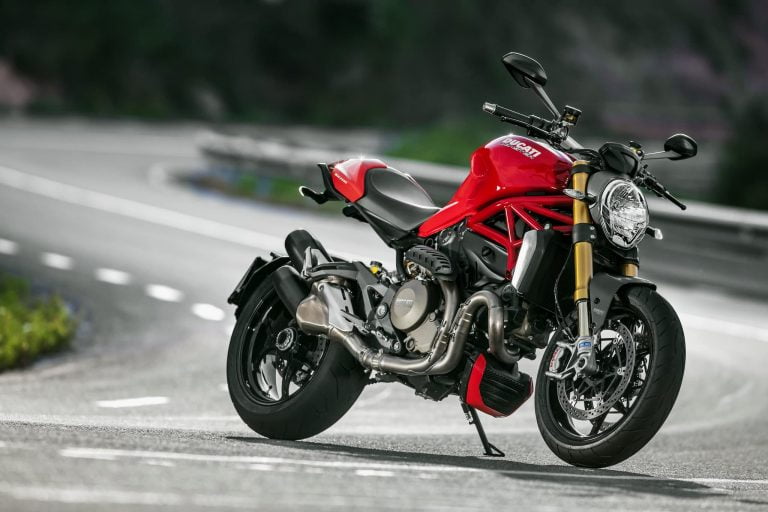Yamaha Niken and Niken GT (2018-21) Maintenance Schedule and Service Intervals
This is the maintenance schedule and associated service intervals for the Yamaha Niken and Niken GT, first released in 2018.
The Yamaha Niken is a visually striking motorcycle with two front wheels. It has the CP3 engine used in the MT-09, XSR900, and Tracer GT, but with a few differences in tuning and in parts used.
So the maintenance for the Niken is quite similar to the maintenance schedule for the first-gen Yamaha MT-09. But there are a few differences, even though they share the same engine.
The maintenance schedule applies to the Yamaha Niken and Niken GT from 2018-2021 with the 847cc CP3 engine.
This site has links from which we earn a commission (which unfortunately nobody can save, not even us). If you appreciate this research work, then please use those links. Thanks.
Yamaha Niken / Niken GT Service Intervals
Like most modern liquid-cooled Yamaha sport motorcycles, service intervals for the Yamaha Niken / Niken GT are every 4000 miles or 6000 km, or 6 months.
At every service, you do an oil change, plus check for leaks and lubrication of moving parts.
Every two services, Yamaha recommends you change the oil filter and spark plug. And every 26600 miles, Yamaha suggests you inspect the valves of the Yamaha Niken / Niken GT. The first of these maintenance intervals is the most important.
You should also keep the fluids up to date, regularly replacing the brake fluid and the coolant.
The service intervals in Europe for the Yamaha Niken / Niken GT are a little different. Yamaha Europe recommends 10000 km or 6000 mile service intervals, and 40000 km service intervals for the valves.
You can see more about the difference between Europe and US service intervals for Yamaha motorcycles here.
See below for items you’ll need to do a service on your Niken, plus the full maintenance schedule.
What you need to service the Yamaha Niken GT— Consumables and Special Tools
If you’re servicing the Niken GT, you at least need motorcycle maintenance tools — things like an oil catch pan, a paddock stand, and so on.
For the Yamaha Niken GT, the manual recommends the following specific consumables.
| Item | Requirement |
|---|---|
| Engine oil | Use Yamalube 10W-40 or Yamalube 10W-50. The manual recommends “Yamalube” and it’s affordable, so why not! You can also use a high-grade synthetic like Motul 7100 10W-40. Don’t over-torque the bolt (spec is 43 Nm/31 lb-ft for the oil drain bolt per the manual) — use a torque wrench if you don’t have experience with how much torque is enough. |
| Oil filter | Needs to be changed every time you change the oil. Either get a stock oil filter (part 5GH-13440-50-00) or a Hiflofiltro HF204RC (has a nut on the end for easy replacement). Torque for the oil filter is 17 Nm/13 lb-ft. |
| Engine coolant | Yamaha recommends Yamacool (a.k.a. “YAMALUBE coolant”), but the manual says any coolant with a 50/50 ethylene glycol pre-mix is the same. |
| Spark Plugs | NGK MR9K9 should be used per the manual. Make sure it’s gapped correctly to 0.8-0.9mm (get a gapping tool) and torqued with a torque wrench to 13 Nm/10 lb-ft. |
| Air filter | Yamaha part number 1RC-14451-00-00, or the K&N alternative YA-8514. |
| Brake pads | Choose OEM, or EBC for more bite and lower fade. You need two sets for the front (two discs, one on each side of the pair of wheels) and one for the rear. * Front: OEM 5SL-25805-00-00, EBC FA252HH * Rear: OEM 5VX-25806-00-00, EBC FA174HH |
And the following general consumables are useful as well.
| Description |
|---|
| Paddock Stand — Makes maintaining your chain or doing other maintenance much easier. |
| Motul chain paste — one of the most highly-regarded chain lubes. Easy to apply, doesn’t fling off. If you need more stuff, get the Motul chain care kit as an affordable package. |
| Always good to have on hand lithium soap-based grease for lubing external pivot points (like the swingarm) and bearings. |
| Use Protect all cable life to lubricate your cables and controls. |
Yamaha Niken GT Maintenance Schedule
Below is the maintenance schedule for the Yamaha Niken and Niken GT.
The original maintenance for the Yamaha Niken is broken into two sections: periodic maintenance for emission control systems, and general maintenance and lubrication. But we’ve combined them in the table below.
Notes on the maintenance schedule for the Yamaha Niken:
- From the end of the maintenance schedule, repeat every 1, 2, or 4 periods, just as you see.
- Follow the earlier of each time-based or distance-based interval. For example, change the oil every 4000 miles or 6 months, whichever comes earlier.
| mi x 1000 (US manual) | 4 | 8 | 12 | 16 | 20 | |
|---|---|---|---|---|---|---|
| Months | 6 | 12 | 18 | 24 | 30 | Every |
| Standard inspection checklist (see below) — Perform | ✓ | ✓ | ✓ | ✓ | ✓ | |
| Engine oil — Change (Yamalube 10W-40) | ✓ | ✓ | ✓ | ✓ | ✓ | |
| Oil filter — Replace (HF204RC) | ✓ | ✓ | ||||
| Check fuel hoses for cracks or damage. Replace if necessary. | ✓ | ✓ | ✓ | ✓ | ✓ | |
| Spark plugs — Check condition. Adjust gap and clean. | ✓ | ✓ | ✓ | |||
| Spark plugs — ReplaceReplace (NGK MR9K9) | ✓ | ✓ | ||||
| Air filter — Replace (K&N YA-8514) | 24000 mi / 40000 km. More often if riding in dusty / wet conditions | |||||
| Valve clearances — Check and adjust valve | 26000 mi (40000 km) | |||||
| Brake fluid — Change (Castrol DOT 4), along with rubber components of brake master cylinder and calipers | 2 years | |||||
| Coolant — Change (Ethylene glycol pre-mix) | 3 years | |||||
| Brake hoses — Replace | 4 years | |||||
| Steering — Check bearing play and steering for roughness | ✓ | 12000 mi / 20000 km | ||||
| Steering — Lubricate with urea grease | ✓ | 12000 mi / 20000 km | ||||
| Swingarm pivot bearing — Moderately repack with lithium soap-based grease. | 32000 mi / 50000 km | |||||
| Rear suspension link pivots — Check operation Correct if necessary | ✓ | ✓ |
Standard inspection checklist
Below is the checklist of items to do at every service per the schedules above.
The items required at break-in service are marked with a check mark in the right-most column.
| Yamaha Niken Standard Inspection Checklist | At break in? |
|---|---|
| [D] Perform dynamic inspection using Yamaha diagnostic tool. Check the error codes. | ✓ |
| * Check throttle grip operation and free play, and adjust if necessary. * Lubricate throttle cable and grip housing (Protect All Cable Life). | ✓ |
| Check clutch operation. Adjust or replace cable. | ✓ |
| Lubricate moving parts and cables thoroughly (lithium soap-based grease, Protect All Cable Life). | ✓ |
| Check lights, signals, and switches operation. | ✓ |
| Check sidestand switch operation and replace if necessary. | ✓ |
| Check brake switch operation, front and rear. | ✓ |
| Check / adjust headlight beam (if necessary) | ✓ |
| Check and adjust fuel injection synchronization. | ✓ |
| Check fuel hoses for cracks or damage. Replace if necessary. | |
| Check brake hoses for cracks or damage, and for correct routing and clamping. | |
| Check cooling system hoses for cracks or damage. Replace if necessary. | |
| Check engine idle speed (Not required in US) | |
| Check front brake operation, fluid level, and for fluid leakage. Replace brake pads if necessary (EBC FA252HH x 2). | ✓ |
| Check rear brake operation, fluid level, and for fluid leakage. Replace brake pads if necessary (EBC FA174HH). | ✓ |
| Check tyre tread depth and for damage. Replace if necessary (see spec below). | |
| Check and adjust tyre pressure as necessary. | |
| Check front fork operation and for oil leakage. Rebuild/ replace if necessary. | |
| Check shock absorber operation and for oil leakage. Replace if necessary. | |
| Check wheel bearings for smooth operation, looseness, or damage. Replace if necessary. | |
| Check swingarm pivot bearing operation and for excessive play. | |
| Check all chassis fitting and fasteners, and tighten/replace as necessary | |
| Lubricate brake lever pivot shaft with silicone grease lightly. | |
| Lubricate brake pedal, clutch lever, and shift pedal pivot shafts with lithium soap-based grease lightly | |
| Check sidestand pivot operation. Lubricate with lithium soap-based grease lightly. | |
| Check crankcase breather hose for cracks or damage. Replace if necessary | |
| Check exhaust system for leakage. Tighten and/or replace gaskets as necessary. |
Maintaining Your Chain on the Yamaha Niken
It’s important to maintain your chain on the Niken, as on any chain-driven motorcycle. Use a good-quality chain lubricant like Motul chain paste, or a Motul chain care kit which comes with a couple of handy tools to maintain the chain.
Yamaha recommends you follow the following chain maintenance schedule every 500 mi / 800 km and after washing the motorcycle, riding in the rain, or riding in wet areas.
| Chain maintenance item |
|---|
| Check drive chain lubrication condition, lubricating if necessary (Motul chain paste) |
| Check drive chain slack, alignment, and condition, adjusting / replacing if necessary |
Naturally, if you track or race your Niken, then attend to your chain more often.
Wheels and Tires
The Yamaha Niken has three wheels, in case you haven’t noticed! The specifications for the front two wheels are the same.
Stock, the Niken ships with Bridgestone A41 sport touring tires
| Wheel | Tire size | Tire pressure (cold) |
|---|---|---|
| Front (both) | 120/70 R 15 M/C 56 V | 225 kPa / 2.25 bar / 33 psi |
| Rear | 190/55 R 17 M/C 75V | 290 kPa / 2.9 bar / 42 psi |
Important — every time you change tires on the Niken, balance the front wheels. It’s more critical on the Niken than on other motorcycles.
About the Yamaha Niken and Niken GT
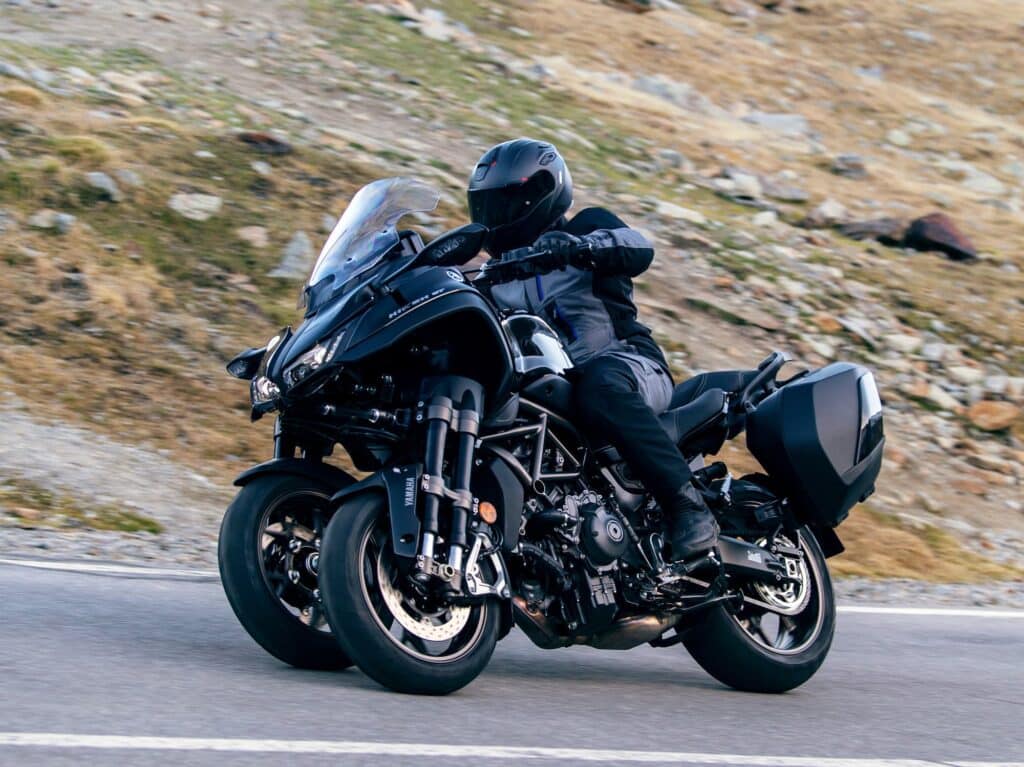
The Yamaha Niken is a three-wheeled adventure sports tourer. Think of it like a Tracer or Tracer GT, except with those unmissable two front wheels.
Naysayers on forums like to say “is that a motorcycle?”. But raving fans of the Niken point out that a Yamaha Niken provides all the joy of a sport-touring motorcycle — head (or helmet) in the air, willing engine, the ability to lean into corners, and long-distance travel comfort — while solving one of the biggest danger issues of motorcycling — front wheel traction.
It’s not just having two wheels up front that gives you the increased contact patch. It’s also the fact that there’s added weight up front and independent suspension to keep them on the road. Having a greater contact patch up front means that as a motorcyclist you’re protected a LOT more from small things than can ruin a whole day’s (or lifetime of) riding, like hitting a large pebble, a small animal, a grease slick, a bit of gravel… all kinds of things that can upset the front around, especially when leaning.
Even though it’s a big, heavy motorcycle that weighs 263 kg wet and has three wheels, riding the Yamaha Niken is a lot like any other motorcycle. You rev it up to launch it and you push to lean into corners. And very adept riders CAN wheelie it, though it’s a lot harder due to all the front-end weight. Depends where your priorities lie.
Besides, 263kg isn’t prohibitively heavy for a motorcycle. There are plenty of heavier, less powerful motorcycles — like many cruisers on the market, for example. It’s just when you compare it to the featherweight MT-09 (that is so light it feels like a toy) that it becomes obvious.
Maintaining the Niken is a little tricker, given that you have two front wheels, but the GT model does come with a centre-stand to make everyday maintenance more pain-free.
Other than that, compared to maintaining the MT-09, the potential differences for the Yamaha Niken are:
- Tyres: You may need an extra one, when it’s time to replace them. Double check that…
- Forks: same. Only one pair has oil in it (the others are just empty guides)
- Steering head bearings: Same as MT-09 — check them every 12K miles/20K km
- Steering linkage: This is the only additional cost. It needs to be inspected and maybe lubricated at the same time as the steering head bearings.
Other than that, maintaining the Niken is the same — keep the chain lubricated, the fluids fresh, and you’ll be good to go for a while.
Like the Tracer GT, the Yamaha Niken GT comes with a few extra things for long distance touring, including heated grips, side cases/panniers, a passenger grab rail, centre stand, comfort seats, a touring windscreen, and an extra 12V electrical outlet. (Many of those from the colder parts of the world are screaming “You had me at heated grips!”)
Ultimately you’re going to cop a bit of heat from haters for riding a three wheeled motorcycle, but people who ride the Niken and aren’t destroying hills everyday on their regular commute love it — everyone agrees it’s a unique bike and worth a test ride. In fifty years time, just like all unusual motorcycles today, it’ll be an icon in museums.
Manual for the Niken and Niken GT
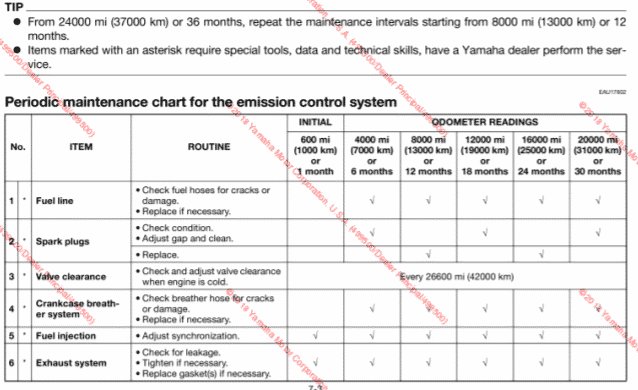
The above information was gleaned from the owner’s manual for the Yamaha Niken GT, comparing different model years. Nothing substantially changed since other years.
You can download it from Yamaha’s website here.
